High-density lipoprotein HDL cholesterol is reduced. High density lipoprotein (HDL) - what is it?
Lipoproteins high density, called “good” cholesterol, are produced in the liver. HDL cholesterol slows down the development of atherosclerosis. It removes "bad" cholesterol from all cells, including those responsible for the formation atherosclerotic plaques.
The study of HDL values is an integral part of basic preventive and therapeutic activities aimed at reducing blood lipid levels.
HDL and LDL
HDL cholesterol is produced in the liver. It appears as a particle consisting mainly of protein, is transported by the blood to all tissues and “takes” lipids from them. The “accepted” cholesterol is transported to the liver, where it becomes part of the bile. Thanks to this mechanism, the body gets rid of excess fat.
LDL is a lipoprotein made primarily of fat. It is responsible for excess cholesterol in tissues, as well as for the formation of atherosclerosis. Therefore, HDL particles act opposite to LDL particles.
"Good" cholesterol - protective effect
High-density lipoproteins slow down the development of atherosclerosis. In addition, they have an antioxidant effect, which is to remove free radicals, which cause damage to the LDL molecule. Damage to LDL particles causes them to remain in the blood for a long time, which contributes to the formation of atherosclerosis. HDL inhibits the production of proinflammatory particles in the vessel. This limits inflammatory processes in him. HDL molecules activate the regenerative potential of the cells lining blood vessels. That is, they have the effect:
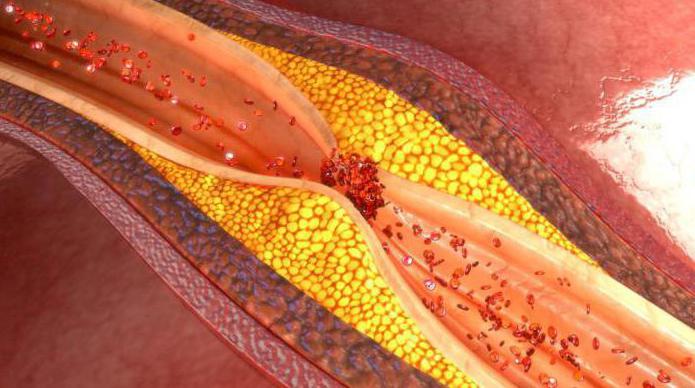
What reduces HDL concentrations?
If high-density lipoprotein cholesterol is reduced, it leads to adverse consequences for good health. There is a gradual deprivation of the body of the mechanism that regulates the level of overall lipid balance.
Factors that reduce high-density lipoprotein levels:

These are basically the same factors that cause an increase LDL level. Therefore, changing diet, increasing physical activity, quitting smoking, appropriate treatment concomitant diseases should become the basis in the treatment of any lipid metabolism disorder. Improving lifestyle is necessary, also because there is still no effective drug, which increases the level of HDL in the blood. Medicines can help lower LDL levels.
HDL cholesterol and cardiovascular disease
The concentration of "good" cholesterol below the limit values is synonymous with an increased risk of developing cardiovascular diseases.
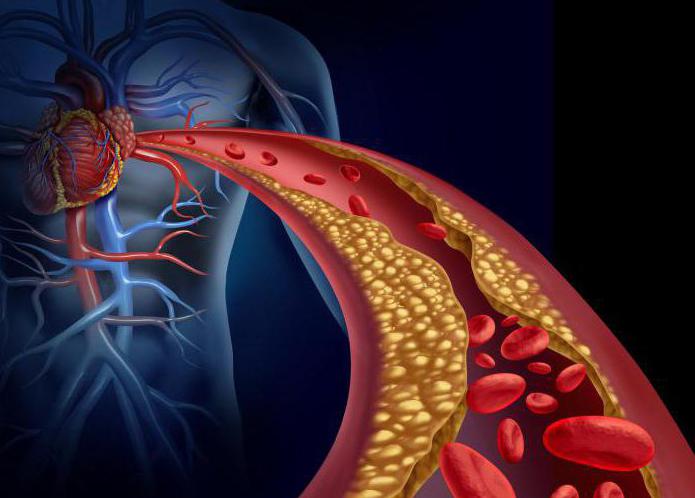
These include:
- arterial hypertension - pressure above 140/90 mm Hg. Art.;
- disease coronary artery, myocardial ischemia and insufficient oxygen supply. Observed limitation physical performance, pain in chest, myocardial infarction may occur;
- cerebral stroke - can lead to paresis of the limbs, muscle paralysis, and limitation in normal functioning;
- renal ischemia, which increases with hypertension;
- ischemia lower limbs leads to pain in the limbs and difficulty walking.
Low HDL cholesterol
The lower the HDL concentration, the higher the risk of the diseases mentioned above. Cardiovascular diseases are the second cause of death (after cancer) in highly developed countries. It should be borne in mind that lifestyle changes after the onset of heart and vascular diseases can lead to significant improvement the patient’s well-being and reduction of certain symptoms. If high-density lipoprotein cholesterol is elevated - the development of atherosclerosis is inhibited and the size of atherosclerotic plaques even decreases. If you combine this with the corresponding pharmacological treatment and lowering LDL, you can achieve really good therapeutic effect. And the risk of, for example, recurrent myocardial infarction will decrease.
Indications for lipid profile testing
High-density lipoproteins are tested if any of the disease risk factors are present of cardio-vascular system, as well as the coexistence of diseases such as:
- diabetes;
- ischemic disease hearts;
- cerebrovascular diseases;
- disturbances of blood flow in peripheral vessels;
- hyperthyroidism or hypothyroidism.
The research is carried out within primary prevention health. This means that such a test should be carried out on everyone healthy person at least once every 5 years. Typically, the study identifies four parameters together:
- total cholesterol level;
- LDL fractions;
- HDL fractions;
- triglycerides.
Preparation and methodology for studying lipid profile
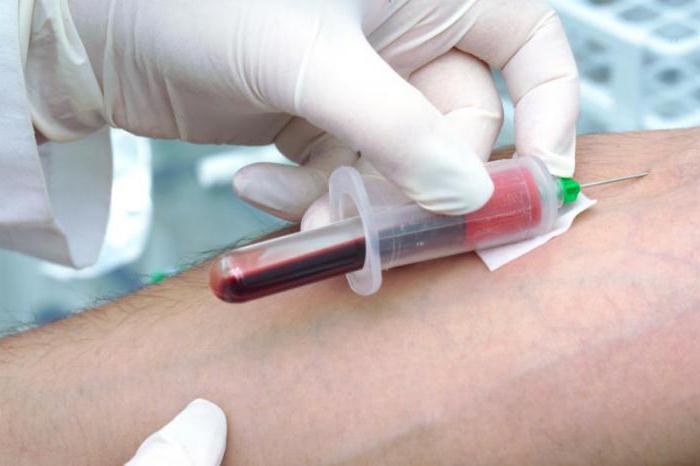 To explore HDL cholesterol in the blood, the patient must prepare for the test in advance. This is the use of a normal diet approximately 3 weeks before the test. It is necessary to avoid overeating, as well as reducing or changing typical eating habits. You should also take medications that affect lipid metabolism, and completely give up alcohol.
To explore HDL cholesterol in the blood, the patient must prepare for the test in advance. This is the use of a normal diet approximately 3 weeks before the test. It is necessary to avoid overeating, as well as reducing or changing typical eating habits. You should also take medications that affect lipid metabolism, and completely give up alcohol.
Immediately before donating a blood sample for testing, the patient must refrain from eating for 12-14 hours. Strenuous physical activity should be avoided, and in case of illness or infection, the test should be postponed for 3 weeks.
After taking the sample venous blood in plasma, “good” cholesterol is designated by the enzymatic method (using esterase and oxidase). High-density lipoproteins (HDL) are noted in mg/dL or mmol/L.
High density lipoproteins are normal
The normal level of the “good” cholesterol fraction is determined depending on gender and is:
- at least 40 mg/dl in men;
- at least 50 mg/dl in women.
Interpretation of research results
In the case of abnormal HDL levels, coexistence also increased level LDL and triglycerides.
You should know that the recommended form of treatment is always a diet limited in animal fats and lifestyle changes, and only then medications are used.
The pharmaceutical products used are fibrates and niacin.
First control study blood lipid testing should not be carried out earlier than 4 weeks after the start of therapy. Optimal treatment evaluation occurs after 3 months.
It is worth remembering that there are certain conditions, including completely physiological ones, that are associated with changes in the level of the HDL fraction:
- concentration can be increased with regular physical training;
- moderate consumption of alcohol, mainly red wine;
- application hormone therapy estrogens.
Decreased concentration occurs:
- in some genetically determined diseases, such as familial HDL deficiency;
- in patients diabetes mellitus;
- in people with metabolic syndrome;
- for obesity.
Diet - rules of application
What to do if your high-density lipoprotein levels are below normal? How to increase HDL levels and reduce HDL concentrations in the blood through diet?
Rules for a balanced diet include:

Foods that increase HDL levels in the body
High-density lipoproteins can be increased in the blood if you include the following foods in your daily menu:
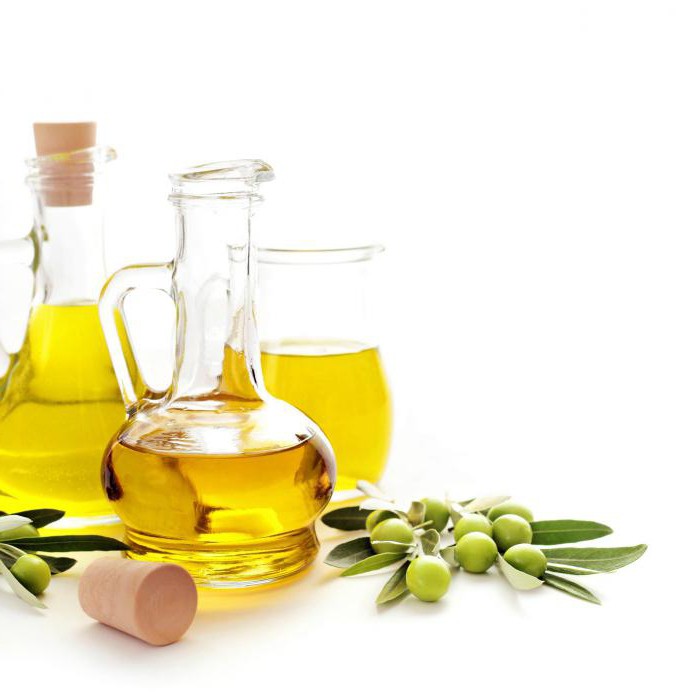
Your diet should limit your intake of sugar, candy, soda and processed foods. Avoid consuming foods that are sources of saturated acids, which are present in fatty meat, dairy products, butter, sour cream.
Lipoproteins (lipoproteins) of high and low density in the blood: what is it, normal, increase
Lipoproteins are complex protein-lipid complexes that are part of all living organisms and are necessary integral part cellular structures. Lipoproteins perform transport function. Their content in the blood is an important diagnostic test, signaling the degree of development of diseases of the body systems.
This is a class of complex molecules that can simultaneously contain free, fatty acid, neutral fats, phospholipids and in various quantitative ratios.
Lipoproteins deliver lipids to various tissues and organs. They consist of non-polar fats located in the central part of the molecule - the core, which is surrounded by a shell formed from polar lipids and apoproteins. This structure of lipoproteins explains their amphiphilic properties: simultaneous hydrophilicity and hydrophobicity of the substance.
Functions and meaning
Lipids play important role in the human body. They are found in all cells and tissues and are involved in many metabolic processes.
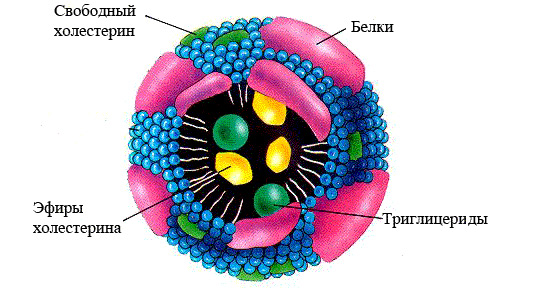
lipoprotein structure
- Lipoproteins are the main transport form of lipids in the body. Since lipids are insoluble compounds, they cannot independently fulfill their purpose. Lipids bind in the blood to proteins - apoproteins, become soluble and form a new substance called lipoprotein or lipoprotein. These two names are equivalent, abbreviated as LP.
Lipoproteins occupy a key position in the transport and metabolism of lipids. Chylomicrons transport fats that enter the body with food, VLDL deliver endogenous triglycerides to the site of disposal, cholesterol enters cells with the help of LDL, HDL has anti-atherogenic properties.
- Lipoproteins increase permeability cell membranes.
- LPs, the protein part of which is represented by globulins, stimulate the immune system, activate the blood coagulation system and deliver iron to the tissues.
Classification
Blood plasma lipids are classified by density(using the ultracentrifugation method). The more lipids a drug molecule contains, the lower their density. There are VLDL, LDL, HDL, and chylomicrons. This is the most accurate of all existing classifications A drug that was developed and proven using a precise and rather painstaking method - ultracentrifugation.
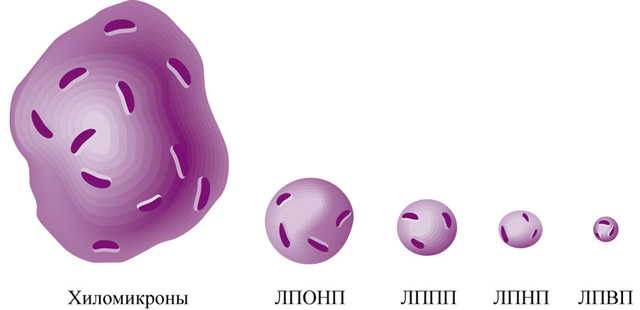
The size of the LP is also heterogeneous. The largest molecules are chylomicrons, and then in decreasing size - VLDL, LPSP, LDL, HDL.
Electrophoretic classification LP is very popular among clinicians. Using electrophoresis, the following classes of lipid were identified: chylomicrons, pre-beta lipoproteins, beta lipoproteins, alpha lipoproteins. This method based on introduction into a liquid medium active substance using galvanic current.
Fractionation LPs are carried out to determine their concentration in the blood plasma. VLDL and LDL are precipitated with heparin, and HDL remains in the supernatant.
Kinds
Currently there are the following types lipoproteins:
HDL (high density lipoprotein)
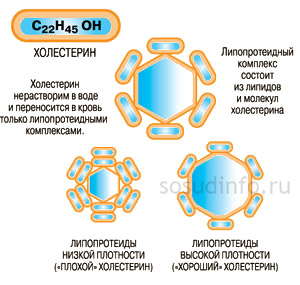
HDL transports cholesterol from body tissues to the liver.
- An increase in HDL in the blood is observed in obesity, fatty hepatosis and biliary cirrhosis of the liver, alcohol intoxication.
- A decrease in HDL occurs when hereditary disease Tangier, caused by the accumulation of cholesterol in tissues. In most other cases, a decrease in the concentration of HDL in the blood is a sign.
The HDL level differs between men and women. In males, the LP value is of this class ranges from 0.78 to 1.81 mmol/l, the norm in women for HDL is from 0.78 to 2.20, depending on age.
LDL (low density lipoprotein)
LDLs are carriers of endogenous cholesterol, triglycerides and phospholipids from the liver to tissues.
This class of drugs contains up to 45% cholesterol and is its transport form in the blood. LDL is formed in the blood as a result of the action of the enzyme lipoprotein lipase on VLDL. When there is an excess of it, they appear on the walls of blood vessels.
Normally, the amount of LDL is 1.3-3.5 mmol/l.
- The level of LDL in the blood increases with hypofunction thyroid gland, nephrotic syndrome.
- A reduced level of LDL is observed with inflammation of the pancreas, hepatic-renal pathology, acute infectious processes, pregnancy.
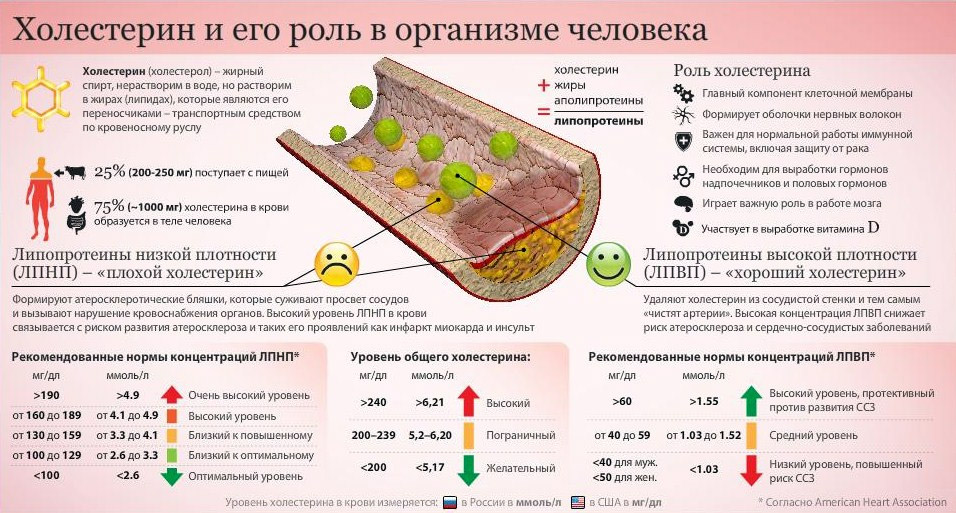
infographics (click to enlarge) - cholesterol and LP, role in the body and norms
VLDL (very low density lipoprotein)
VLDL is formed in the liver. They transport endogenous lipids, synthesized in the liver from carbohydrates, to tissues.
These are the largest LPs, second in size only to chylomicrons. They are more than half triglycerides and contain small amounts of cholesterol. When there is an excess of VLDL, the blood becomes cloudy and takes on a milky tint.
VLDL is a source of “bad” cholesterol, from which plaques form on the vascular endothelium. Gradually, the plaques increase, accompanied by the risk of acute ischemia. VLDL is elevated in patients with kidney disease.
Chylomicrons
Chylomicrons are absent in the blood of a healthy person and appear only when lipid metabolism is disturbed. Chylomicrons are synthesized in epithelial cells mucous membrane small intestine. They deliver exogenous fat from the intestines to peripheral tissues and liver. Most of the transported fats are triglycerides, as well as phospholipids and cholesterol. In the liver, under the influence of enzymes, triglycerides break down and fatty acids are formed, some of which are transported to the muscles and adipose tissue, and the other part binds to blood albumin.
![]()
what do major lipoproteins look like?
LDL and VLDL are highly atherogenic- containing a lot of cholesterol. They penetrate the artery wall and accumulate there. When metabolism is disrupted, LDL and cholesterol levels rise sharply.
HDL are the safest against atherosclerosis. Lipoproteins of this class remove cholesterol from cells and promote its entry into the liver. From there, it enters the intestines along with bile and leaves the body.
Representatives of all other classes of drugs deliver cholesterol into cells. Cholesterol is a lipoprotein that is part of the cell wall. It is involved in the formation of sex hormones, the process of bile formation, and the synthesis of vitamin D, necessary for the absorption of calcium. Endogenous cholesterol is synthesized in liver tissue, adrenal cells, intestinal walls and even in the skin. Exogenous cholesterol enters the body along with animal products.
Dyslipoproteinemia is a diagnosis for disorders of lipoprotein metabolism
Dyslipoproteinemia develops when two processes are disrupted in the human body: the formation of lipoproteins and the rate of their elimination from the blood. N An imbalance in the ratio of lipoproteins in the blood is not a pathology, but a development factor chronic disease, in which the arterial walls become denser, their lumen narrows and the blood supply is disrupted internal organs.
With an increase in blood cholesterol levels and a decrease in HDL levels, atherosclerosis develops, leading to development of deadly diseases.
Etiology
Primary dyslipoproteinemia is genetically determined.

Reasons secondary dyslipoproteinemias are:
- Physical inactivity,
- Diabetes,
- Alcoholism,
- Kidney dysfunction
- Hypothyroidism,
- Hepatic-renal failure,
- Long-term use of certain medications.
The concept of dislipoproteinemia includes 3 processes - hyperlipoproteinemia, hypolipoproteinemia, alipoproteinemia. Dyslipoproteinemia is quite common: every second inhabitant of the planet experiences similar changes in the blood.
Hyperlipoproteinemia - increased content LP in the blood due to exogenous and endogenous reasons. The secondary form of hyperlipoproteinemia develops against the background of the underlying pathology. At autoimmune diseases LPs are perceived by the body as antigens to which antibodies are produced. As a result, antigen-antibody complexes are formed, which are more atherogenic than the drugs themselves.

Alipoproteinemia is a genetically determined disease with an autosomal dominant type of inheritance. The disease is manifested by enlarged tonsils with an orange coating, hepatosplenomegaly, lymphadenitis, muscle weakness, decreased reflexes, hyposensitivity.
Hypolipoproteinemia — low levels of LP in the blood, often asymptomatic. The causes of the disease are:
- Heredity,
- Poor nutrition
- Passive lifestyle,
- Alcoholism,
- Pathology of the digestive system,
- Endocrinopathy.
Dyslipoproteinemias are: organ or regulatory , toxigenic, basal - study of the level of LP on an empty stomach, induced - study of the level of LP after eating, medications or physical activity.
Diagnostics
It is known that excess cholesterol is very harmful for the human body. But a lack of this substance can lead to dysfunction of organs and systems. The problem lies in hereditary predisposition, as well as in lifestyle and dietary habits.
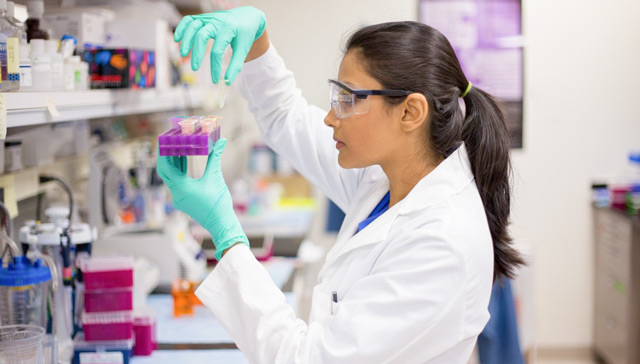
Diagnosis of dyslipoproteinemia is based on medical history, patient complaints, clinical signs- presence of xanthoma, xanthelasma, lipoid arch of the cornea.
The main diagnostic method for dyslipoproteinemia is a blood lipid test. The atherogenicity coefficient and the main indicators of the lipid profile - triglycerides, total cholesterol, HDL, LDL - are determined.
Lipidogram - method laboratory diagnostics, which identifies lipid metabolism disorders leading to the development of heart and vascular diseases. A lipidogram allows the doctor to assess the patient’s condition, determine the risk of developing atherosclerosis of the coronary, cerebral, renal and hepatic vessels, as well as diseases of the internal organs. Blood is donated to the laboratory strictly on an empty stomach, at least 12 hours after the last meal. One day before the test, alcohol intake is excluded, and smoking is excluded an hour before the test. On the eve of the analysis, it is advisable to avoid stress and emotional overstrain.
The enzymatic method for studying venous blood is the main one for determining lipids. The device records samples pre-stained with special reagents. The diagnostic method allows you to conduct mass examinations and obtain accurate results.
Take tests to determine lipid spectrum for preventive purposes, starting from youth, it is necessary once every 5 years. Persons over 40 years of age should do this annually. Blood tests are carried out in almost every district clinic. Patients suffering from hypertension, obesity, heart, liver and kidney diseases are also prescribed a lipid profile. Compounded heredity, existing risk factors, monitoring the effectiveness of treatment - indications for prescribing a lipid profile.
The results of the study may be unreliable after eating the day before, smoking, stress, acute infection, during pregnancy, taking certain medications.
Diagnosis and treatment of pathology is carried out by an endocrinologist, cardiologist, therapist, doctor general practice, family doctor.
Treatment
plays a huge role in the treatment of dyslipoproteinemia. Patients are advised to limit the consumption of animal fats or replace them with synthetic ones, and eat up to 5 times a day in small portions. The diet must be enriched with vitamins and dietary fiber. You should avoid fatty and fried foods and replace meat sea fish, eat a lot of vegetables and fruits. General restorative therapy and sufficient exercise stress improve general state sick.

Figure: useful and harmful “diets” from the point of view of drug balance
Lipid-lowering therapy and antihyperlipoproteinemic drugs are intended to correct dyslipoproteinemia. They are aimed at reducing cholesterol and LDL levels in the blood, as well as increasing HDL levels.
Among the drugs for the treatment of hyperlipoproteinemia, patients are prescribed:
- – “Lovastatin”, “Fluvastatin”, “Mevacor”, “Zocor”, “Lipitor”. This group of drugs reduces the production of cholesterol by the liver, reduces the amount of intracellular cholesterol, destroys lipids and has an anti-inflammatory effect.
- Sequestrants reduce cholesterol synthesis and remove it from the body - Cholestyramine, Colestipol, Cholestipol, Cholestan.
- I reduce the level of triglycerides and increase the level of HDL - “Fenofibrate”, “Ciprofibrate”.
- B vitamins.
Hyperlipoproteinemia requires treatment with lipid-lowering drugs "Cholesteramine", " Nicotinic acid", "Miskleron", "Clofibrate".
Treatment of the secondary form of dyslipoproteinemia consists of eliminating the underlying disease. Patients with diabetes are advised to change their lifestyle, regularly take antihyperglycemic drugs, as well as statins and fibrates. In severe cases, insulin therapy is required. In case of hypothyroidism, it is necessary to normalize the function of the thyroid gland. For this purpose, patients undergo hormone replacement therapy.
Patients suffering from dyslipoproteinemia are recommended after the main treatment:
- Normalize body weight,
- Dose physical activity
- Limit or eliminate alcohol consumption,
- If possible, avoid stress and conflict situations,
- Stop smoking.
Video: lipoproteins and cholesterol - myths and reality
Video: lipoproteins in blood tests - “Live Healthy!” program
We'll find out what the risks are associated with low HDL cholesterol. We explore the symptoms and causes of low cholesterol values well, and we see how to return values to the level of a physiological diet.
What is HDL cholesterol
A low HDL level is said to be when concentration V peripheral blood turns out below 40 mg/dl for men and 50 mg/dl for women.
It would seem that, low level cholesterol may be interpreted as a sign good health However, in the case of HDL, the opposite is true.
Why low levels of good cholesterol are harmful
Of course, you know that high cholesterol levels are the enemy of cardiovascular health. But this axiom does not apply to all types of cholesterol. In fact, in the case of HDL, the higher its concentration, the lower the risk of developing atherosclerotic changes and, as a result, heart disease.
Cholesterol is an essential component of the proper functioning of the body (a component of cell membranes, a precursor important hormones, for example, steroids). To move freely with the bloodstream, cholesterol is packaged in special proteins that increase its solubility.
Basic information about lipoproteins:Low density lipoproteins. They are also known as “bad” cholesterol and are produced in the liver. Under normal physiological conditions, this process is balanced. In the sense that each cell is able to maintain the level of cholesterol necessary for its functioning, and return the excess to the liver. If this natural balance will be upset, there will be an increase in the level of LDL in the blood, which can be deposited on the walls of the arteries and lead to the formation of atherosclerotic plaques. L high density hypoproteins. Also known as “good” cholesterol. They are involved in the reverse transport of excess cholesterol. That is, they obtain excess lipoproteins circulating there from the cells and transfer them to the liver. In addition, HDLs perform other important functions: protect the body from atherosclerotic deposits and from the occurrence of cardiovascular diseases such as heart attack and stroke. |
High HDL values not only prevent plaque deposition by preventing LDL oxidation, but also promote the removal of existing plaques by preventing the adhesion of monocytes to the vessel wall and, as a result, prevent possible obstruction of blood vessels.
Optimal levels HDL concentrations are:
- Men: 60 mg/dL or more
- Women: 60 mg/dL or more
What are the symptoms of decreased HDL?
A decrease in HDL values occurs asymptomatic and few people notice this, only with routine periodic medical monitoring.
Symptoms occur when health has already been damaged and diseases are developing.
Reasons for lower cholesterol values
But what are the reasons that can lead to decrease in HDL values?
There are many of them, and they are not always associated with diseases:
- Pregnancy and menopause are the most common causes of physiological decreases in HDL cholesterol values. The reason should be sought in hormonal changes. Latest Research showed noticeable decrease cholesterol levels are observed for two years after pregnancy.
- During menopause lower cholesterol is associated with the absence of estrogen, which regulates cholesterol synthesis.
- Birth control pills can reduce HDL cholesterol levels because they contain progestin, which leads to increased levels LDL cholesterol Thus, the value of total cholesterol increases.
- Poor nutrition: rich fatty foods and low in vegetables, fiber and monounsaturated fats, which leads to an increase in the proportion of LDL cholesterol and a decrease in the proportion of HDL cholesterol.
- Misbehavior: sedentary lifestyle life leads to an increase in the level of “bad” cholesterol and a decrease in “good” cholesterol.
- Smoking: The mechanism that links smoking to HDL cholesterol is not entirely clear, but quitting smoking has been shown to markedly increase good cholesterol levels.
- Obesity: With obesity, an excess of triglycerides occurs, which leads to an increase in the concentration of very low-density lipoproteins and a number of changes in the cholesterol chain: high-density lipoproteins become smaller and lose their atherogenic functions.
Diseases that lead to a decrease in good cholesterol levels:
- celiac disease or food allergy lower cholesterol levels because the body does not absorb foods, and therefore does not receive HDL in the diet.
- hypothyroidism and liver disease such as hepatitis and cirrhosis of the liver; Excess thyroid hormones lead to increased metabolism.
- Medicines, such as beta blockers, diuretics, interferon, or statins, used to lower cholesterol.
Risks of Low HDL Levels
Considering protective function HDL in relation to the arteries, low HDL cholesterol, exposes the body high risk cardiovascular diseases.
When HDL cholesterol levels fall far below optimal levels, the total cholesterol ratio is above 5, then damage to the arteries can lead to:
- Atherosclerosis: body fat in the arteries, which entail a decrease in blood flow.
- Stroke: obstruction or rupture of an artery in the brain, which leads to the death of brain tissue.
- Heart attack: reduction or cessation of blood flow, which leads to the death of the heart muscle.
- Cardiac ischemia: complete or partial stoppage of blood flow to the heart.
What to do to increase HDL levels
Quit smoking. Elimination of smoking entails an increase in HDL levels by approximately 10%. Especially if you add to this physical activity(at least 5 days a week for 30 minutes): swimming, cycling, running, brisk walking, gardening - anything that increases your heart rate.
Lose overweight . Losing 3 kg of weight increases HDL levels by 1 mg/dL of blood.
Follow the rules rational nutrition . The basis of such a diet should be the consumption of healthy fats. Specifically, monounsaturated and polyunsaturated, in the latter case omega 3, found in hard-shelled fruits and fatty fish.
Drinking one or two glasses of red wine per day. Not everyone agrees with this recommendation, but wine certainly helps maintain high HDL levels. It is possible that this is the reason that explains the French paradox. The French, being heavy consumers of saturated fats ( butter, fatty meats) have a low incidence of cardiovascular disease.
Taking drugs that increase HDL the most common is niacin. There are also supplements based on this ingredient. It should not be used without consulting a doctor because there may be side effects on liver function.
Diet to increase cholesterol values
To reduce the risk of cardiovascular disease, you need to eat foods that help increase HDL cholesterol and reduce LDL cholesterol.
In particular:
- Fish omega-3 (fats) rich foods such as salmon or swordfish.
- Cereals, especially whole grains such as bread and pasta.
- Low-fat boiled sausage or low-fat ham.
- Low-fat cheese, such as mozzarella, ricotta, goat cheese.
- Milk and yogurt.
- Lean meat, such as turkey, chicken and rabbit.
- Dried fruits such as hazelnuts, walnuts and almonds because they contain omega-3s.
- Antioxidant Rich Foods, such as vitamin C, which is found in kiwis, broccoli, oranges and lemons.
- Some legumes, such as soybeans, which contain phytoestrogens, substances that can mimic the effects of estrogen and reduce cholesterol levels.
A diet that can help you keep your bad cholesterol levels low - vegetarian diet , since it excludes the consumption of animal fats and involves the consumption of large amounts of fruits and vegetables rich in vegetable fats, containing sterols that have a structure similar to cholesterol and stimulate the reduction of total cholesterol.
Lipids are fats that do not dissolve in water, so in its purest form they are not present in the blood because they cannot move and be transported along with the bloodstream.
Therefore, nature provided a cohesive substance in which fats acquire solubility in the blood and greater mobility - these are lipoproteins (or lipoproteins). They are a complex consisting of fats and proteins, externally resembling a soft, waxy mass that is found in almost all parts of the body and is part of cellular structures. To many, this substance is better known as cholesterol.
It is not enough to know one concept; for diagnostic purposes, specialists analyze the state of the subclasses and fractions of this complex compound. One such subgroup is high-density lipoprotein (or HDL). Today we will tell you what HDL is in biochemical analysis blood, what deviations indicate, and what norm is acceptable for a healthy person.
Which cholesterol is good and which is bad?
No matter how surprising it may sound to some, cholesterol does not always cause harm to the body; in acceptable quantities, it is even necessary for the body to build cell membranes, to participate in metabolic processes, the production of sex hormones, and much more.
Scientists have long been dividing cholesterol into “bad” and “good”. We usually get the bad one with food, along with fried sausages, sausages, canned food, smoked meats, fast food, mayonnaise and other very fatty and heavy foods. This does not mean that the body does not need it at all; it is capable of supporting and stimulating well. immune system, but only when it is in permissible quantity.
Good, healthy cholesterol is produced human body to combat negative particles and normalize vital processes.
This is the high-density lipoprotein in question. He helps drive harmful substances back to the liver for processing, serves as a building material for cells, helps to establish the production of hormones by the adrenal glands, in addition, is responsible for the psycho-emotional state of a person, prevents the occurrence of depressive state and sudden mood swings. In layman's terms, HDL is the “good” cholesterol. And therefore if HDL is lowered, this is absolutely not good sign, in this case, the risk of atherosclerosis, heart attack, stroke and other blood vessel diseases increases significantly.
Thus, high- and low-density lipoproteins have almost opposite functions and effects on the body, and therefore diagnostic value these substances are different.
HDL norm
In order to evaluate possible risks development of cardiac ischemia, or myocardial infarction, atherosclerosis or the appearance of blood clots, as well as to select the correct treatment tactics, cardiologists, therapists and endocrinologists often prescribe to the patient biochemical research blood.
Lipoprotein levels may vary for different people age category and gender. The normal HDL level for a healthy person is:
- for children:
- up to 5 years - 0.98-1.94 mmol/l;
- 5-10 years - 0.93-1.94 mmol/l;
- 10-15 years - 0.96-1.91 mmol/l;
- over 15 years - 0.91-1.63 mmol/l.
- for adults:
- from 20 years - 0.78-2.04 mmol/l;
- from 30 years - 0.72-1.99 mmol/l;
- from 40 years old - 0.7-2.28 mmol/l;
- from 50 years old - 0.72-2.38 mmol/l;
- after 60-65 years - 0.78-2.48 mmol/l.
It should be noted that the norm of the indicator may differ slightly, depending on the laboratory in which the research is carried out.
The HDL level in men is slightly lower than in women. A reading of less than 1.036 mmol/L for men and 1.30 mmol/L for women leads the doctor to believe that high-density cholesterol is lower permissible norm, which means the risk of cardiovascular diseases is much higher.
Often, doctors test high-density lipoprotein cholesterol levels to assess the potential risk of ischemia.
relative to the total amount of cholesterol in the blood. For this purpose, an atherogenic coefficient was created, showing the balance between “good” and total cholesterol.
KA= Total cold - HDL/HDL.
Normally, this coefficient should be in the range of 2-2.5 (for newborns - no more than 1, for men after 40 years - no more than 3.5).
Low HDL cholesterol, what does this mean?
The level of beneficial cholesterol substances in the blood may differ from standard values for a number of reasons: various reasons, For example poor nutrition, bad habits, rhythm of life, etc.
But maybe HDL cholesterol is also lowered pathological reasons, these are:
- vascular atherosclerosis;
- endocrine diseases and violations;
- cholelithiasis;
- hepatic and kidney diseases: cirrhosis, nephrotic syndrome, etc.;
- hyperlipoproteinemia type IV;
- and etc. infectious diseases in the acute stage.
The level of “good” cholesterol may decrease due to long-term use some medicines, transferred severe stress, or acute infectious exposure. In this case, the patient is prescribed a repeat study, after about 1.5-2 months.
High-density lipoproteins are elevated, what does this mean?
After studying the information about HDL, you might think that increased rate is a favorable sign for the body, because this substance prevents the formation of excess cholesterol, and therefore reduces the risk of cholesterol plaques and the development of all kinds of ailments. This is true, but not always. HDL cholesterol is elevated, what does this mean?
Yes, of course, if high-density lipoproteins are elevated in the blood, doctors say that the likelihood of developing ischemia (CHD) is minimal, because There are more than enough “useful” components and they actively do their job. However, when HDL cholesterol is significantly elevated, there is reason to suspect some problems in the body. Such pathological conditions, we can highlight a few, these include:
- hereditary promotion lipoproteins in the blood - hyperlipoproteinemia;
- biliary (primary) cirrhosis of the liver;
- Hepatitis B chronic form;
- alcoholism or other kind chronic intoxication body.
Also, I would like to note that there are some factors that can affect the result and provoke an increase in the indicator, for example:
- pregnancy period (therefore, it is recommended to take the test no earlier than 6-8 weeks after birth);
- taking statins, estrogens, fibrates, cholistyramines, or insulin.
How to increase HDL cholesterol?
As we already said, unique feature cholesterol of the HDL fraction is that it is denser and is able to transfer “excess” cholesterol from organs and vessels back to the liver, from where it will subsequently be excreted from the body. Scientists have proven that increasing HDL by just 0.02 mmol/l reduces the risk of heart attack by more than 3%.
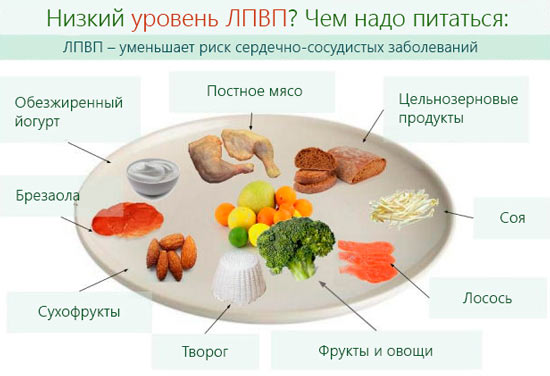
Therefore, the question often arises on the Internet about how to increase good cholesterol and lower bad cholesterol.
It should be understood that the terms “bad” and “good” cholesterol are used to explain the problem more easily to patients. Well, based on the properties of various subclasses of cholesterol.
So, in order to increase the level good cholesterol, you must first of all follow the recommendations for reducing LDL, i.e. “bad” cholesterol. To do this, you need:
- reduce the consumption of saturated trans fats, they are usually found in maximum quantities in products of animal origin (meat, lard, cream, butter...);
- decrease daily consumption calories, the best option will include fiber-rich vegetables, berries and fruits in the menu;
- increase physical activity, we're talking about about useful gymnastic and cardio exercises;
- to refuse from bad habits;
- make it a rule to drink green tea, it contains polyphenols that help reduce general level cholesterol, and at the same time increase HDL. Cranberry juice has similar properties.
So that in the future you are not overtaken by a whole “bouquet” of diseases and problems with blood vessels, think about your health and watch your diet now!
High-density lipoproteins are compounds consisting of lipids (fats) and proteins. They ensure the processing and removal of fats from the body, which is why they are called “ good cholesterol».
Synonyms Russian
HDL, high density lipoprotein, HDL, HDL cholesterol, alpha cholesterol.
SynonymsEnglish
HDL, HDL-C, HDL Cholesterol, High-density lipoprotein cholesterol, High-density lipoprotein, Alpha-Lipoprotein Cholesterol.
Research method
Colorimetric photometric method.
Units
mmol/l (millimoles per liter).
What biomaterial can be used for research?
Venous blood.
How to properly prepare for research?
- Do not eat for 12 hours before donating blood.
- Avoid physical and emotional stress and do not smoke for 30 minutes before the test.
General information about the study
Cholesterol (CH, cholesterol) is a fat-like substance, vital necessary for the body. The correct scientific name for this substance is “cholesterol” (the ending -ol indicates that it belongs to alcohols), however, the name “cholesterol” has become widespread in the popular literature, which we will use later in this article. Cholesterol is formed in the liver and also enters the body with food, mainly meat and dairy products. Cholesterol is involved in the formation of cell membranes of all organs and tissues of the body. Hormones are created on the basis of cholesterol, which are involved in the growth, development of the body and the implementation of the reproduction function. Bile acids are formed from it, thanks to which fats are absorbed in the intestines.
Cholesterol is insoluble in water, so to move around the body it is “packed” into a protein shell consisting of special proteins - apolipoproteins. The resulting complex (cholesterol + apolipoprotein) is called lipoprotein. Several types of lipoproteins circulate in the blood, differing in the proportions of their components:
- very low density lipoproteins (VLDL),
- low density lipoproteins (LDL),
- high density lipoproteins (HDL).
High-density lipoproteins consist mainly of protein and contain some cholesterol. Their main function is to transport excess cholesterol back to the liver, from where it is excreted as bile acids. Therefore, HDL cholesterol (HDL-C) is also called “good cholesterol.” HDL makes up about 30% of the total cholesterol (cholesterol) in the blood.
If a person has hereditary predisposition to high cholesterol or he eats too much fatty foods, then the level of cholesterol in the blood may increase, so that its excess will not be completely eliminated by high-density lipoproteins. It begins to be deposited in the walls of blood vessels in the form of plaques, which can limit the movement of blood through the vessel and also make the vessels more rigid (atherosclerosis), which significantly increases the risk of heart disease (coronary artery disease, heart attack) and stroke.
High levels of HDL cholesterol reduce the risk of developing plaques in blood vessels, as they help remove excess cholesterol from the body. Decrease in HDL cholesterol even with normal level total cholesterol and its fractions leads to the progression of atherosclerosis.
What is the research used for?
- To assess the risk of developing atherosclerosis and heart problems.
- To monitor the effectiveness of a low-fat diet.
When is the study scheduled?
- Analysis for HDL is carried out during planned preventive examinations or when total cholesterol is elevated as part of the lipid profile. It is recommended that all adults over 20 years old have a lipid profile at least once every 5 years. It may be prescribed more frequently (several times a year) if the patient is prescribed a diet limited in animal fats and/or is taking cholesterol-lowering medications. In these cases, it is checked whether the patient achieves the target level of HDL cholesterol and total cholesterol and, accordingly, whether his risk of cardiovascular diseases is reduced.
- With existing risk factors for developing cardiovascular diseases:
- smoking,
- age (men over 45 years old, women over 55 years old),
- promotion blood pressure(140/90 mmHg and above),
- cases high cholesterol or cardiovascular diseases in other family members (heart attack or stroke in a close male relative under 55 years of age, a female relative under 65 years of age),
- existing coronary heart disease, previous myocardial infarction or stroke,
- diabetes,
- excess body weight,
- alcohol abuse,
- reception large quantity foods containing animal fats,
- low physical activity.
- If a child has a history of high cholesterol or heart disease in the family at a young age, then it is recommended that he take a cholesterol test for the first time between the ages of 2 and 10 years.
What do the results mean?
Reference values: 1.03 - 1.55 mmol/l.
The concept of “normal” is not entirely applicable to the level of HDL cholesterol. For different people With different numbers of risk factors, the HDL level will be different. To determine the risk of developing cardiovascular disease more accurately for a specific person, it is necessary to evaluate all predisposing factors.
In general, we can say that a reduced level of HDL predisposes to the development of atherosclerosis, and a sufficient or high level prevents this process.
In adults, HDL cholesterol, depending on the level, can be assessed as follows:
- less than 1.0 mmol/l in men and 1.3 mmol/l in women – high risk development of atherosclerosis and cardiovascular diseases, regardless of other risk factors,
- 1.0-1.3 mmol/l in men and 1.3-1.5 mmol/l in women – average risk of developing atherosclerosis and cardiovascular diseases,
- 1.55 mmol/l and above – low risk of developing atherosclerosis and cardiovascular diseases; at the same time, the vessels are protected from negative influence excess cholesterol.
Causes reduced level HDL:
- heredity (Tangier disease),
- cholestasis - stagnation of bile, which can be caused by liver disease (hepatitis, cirrhosis) or gallstones,
- severe liver disease,
- untreated diabetes mellitus,
- chronic inflammation of the kidneys leading to nephrotic syndrome,
- chronic renal failure.

